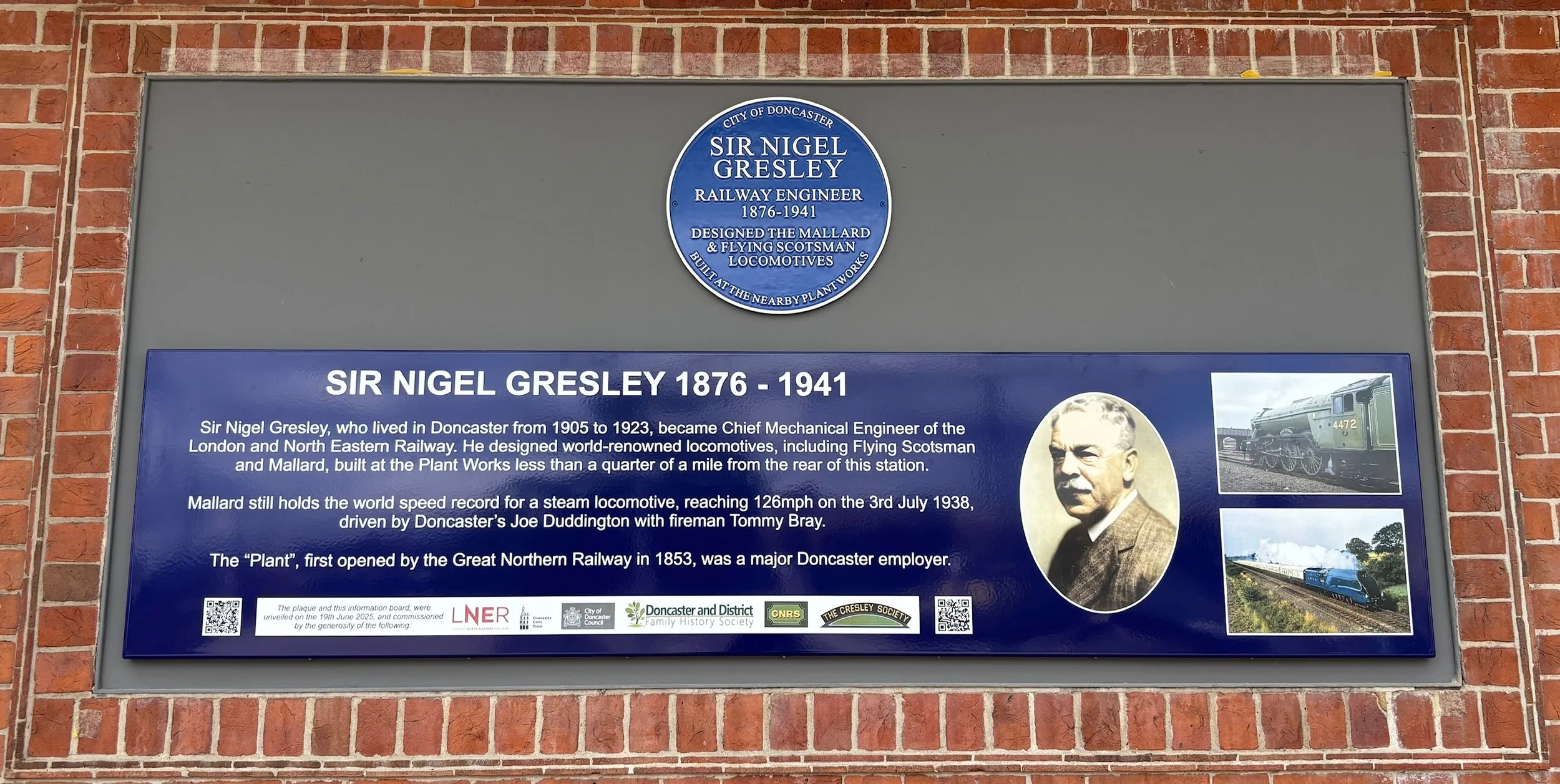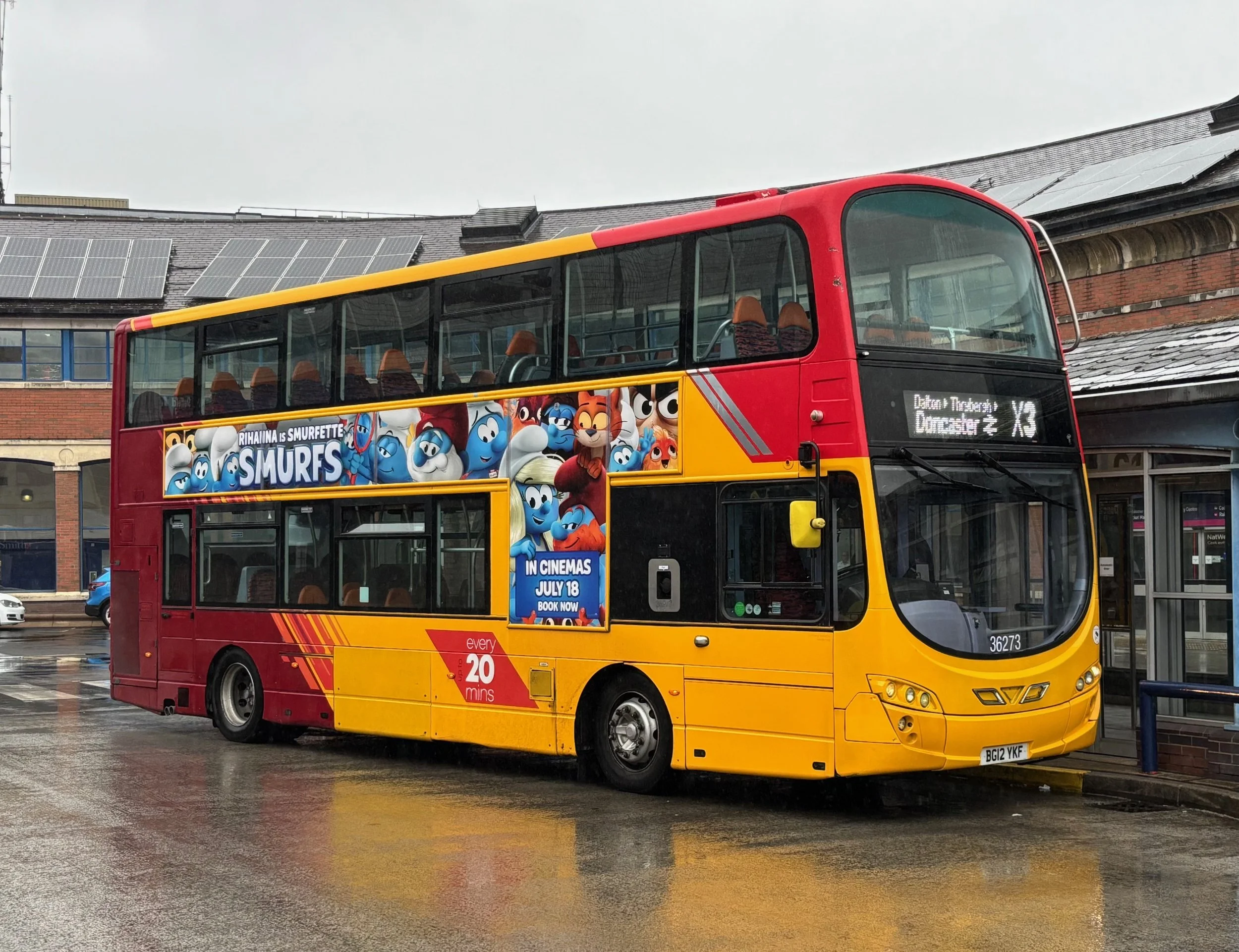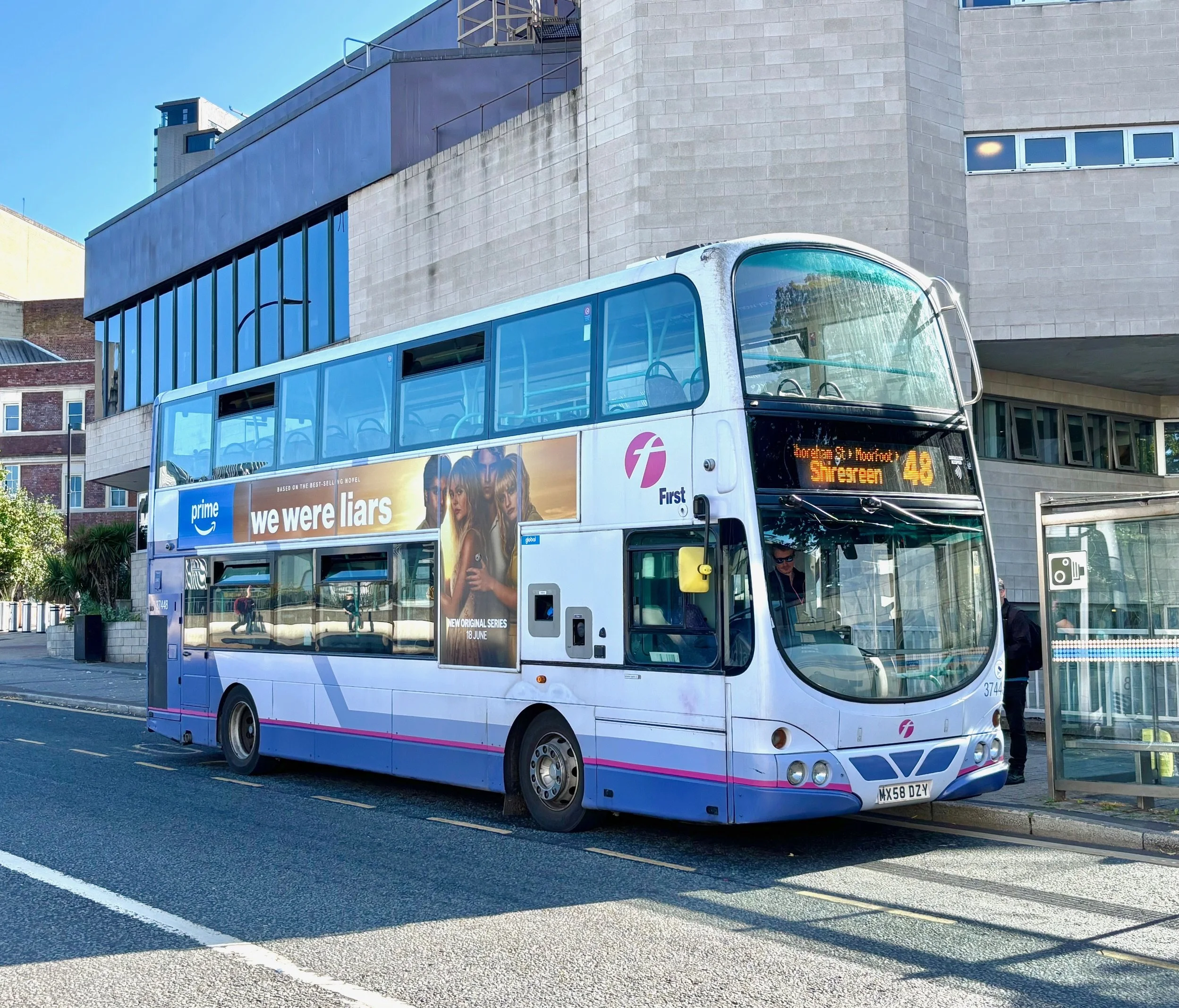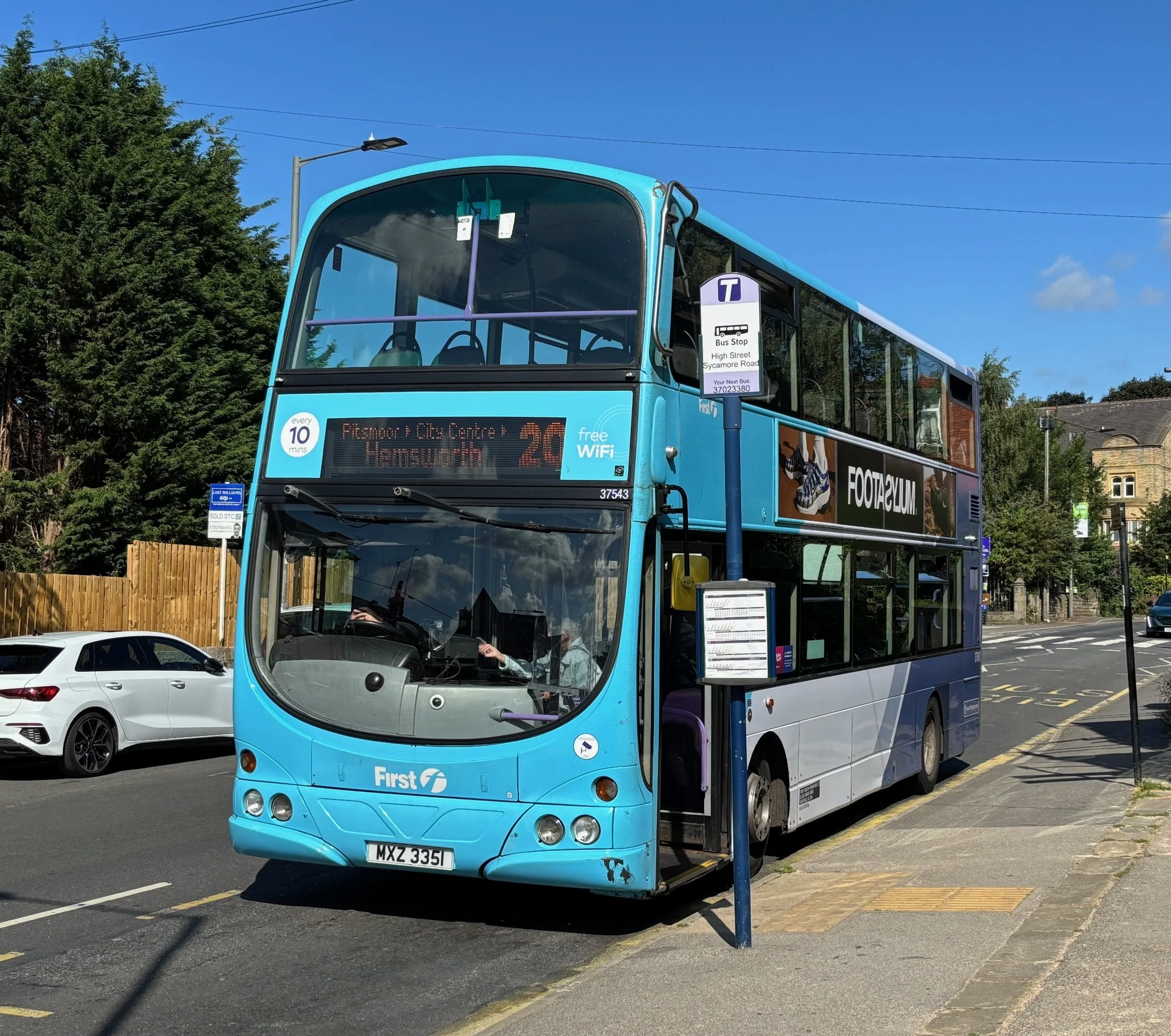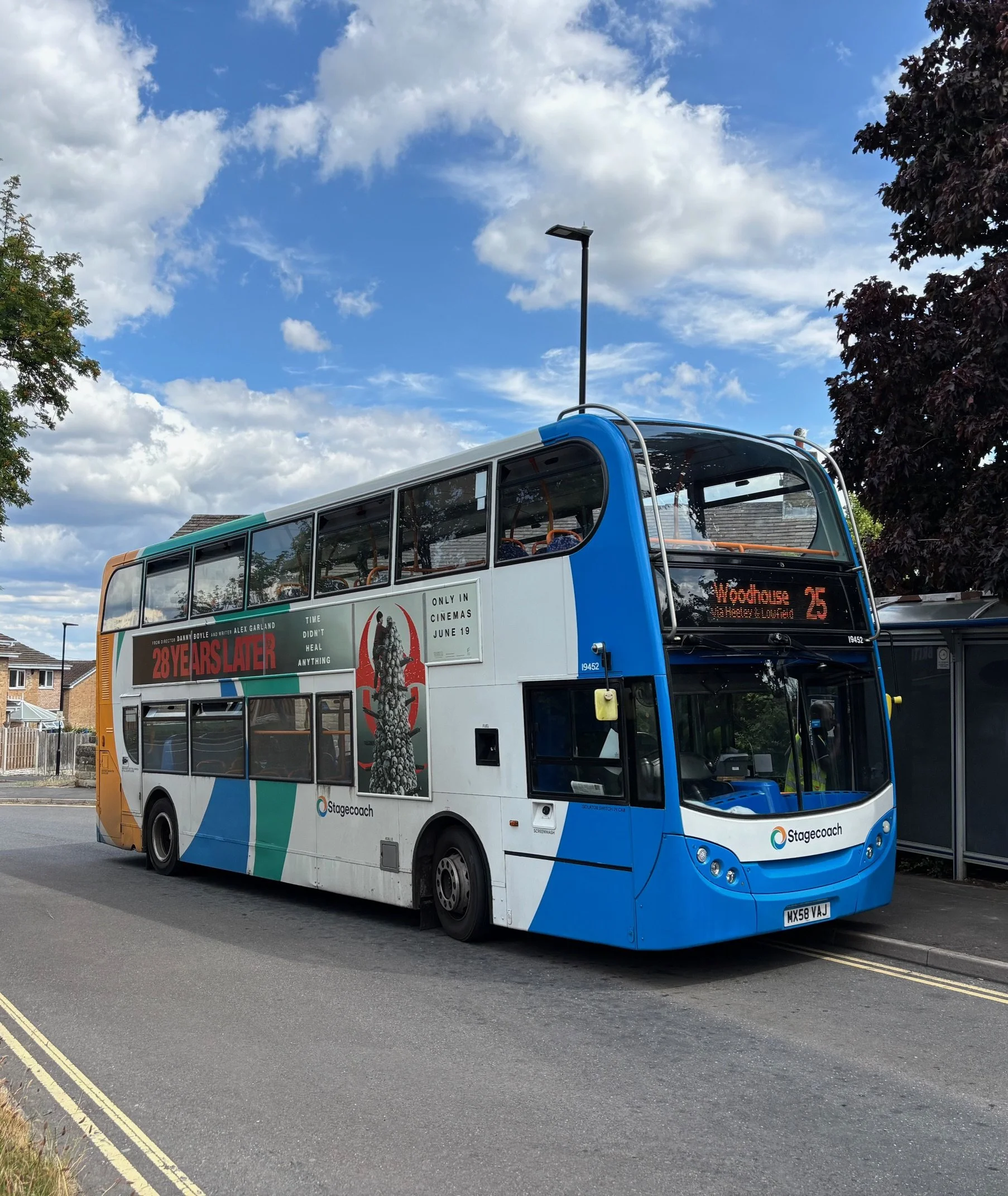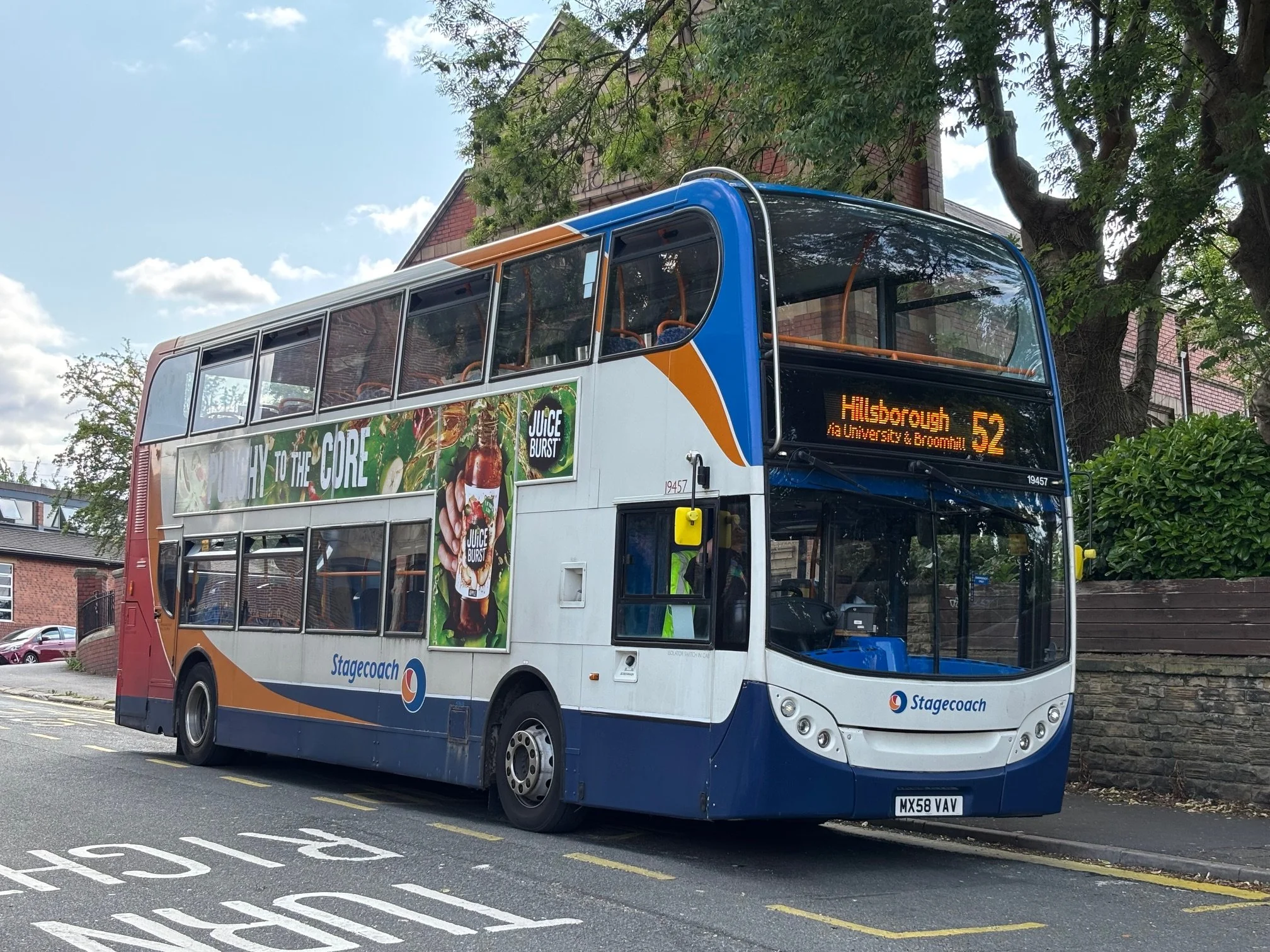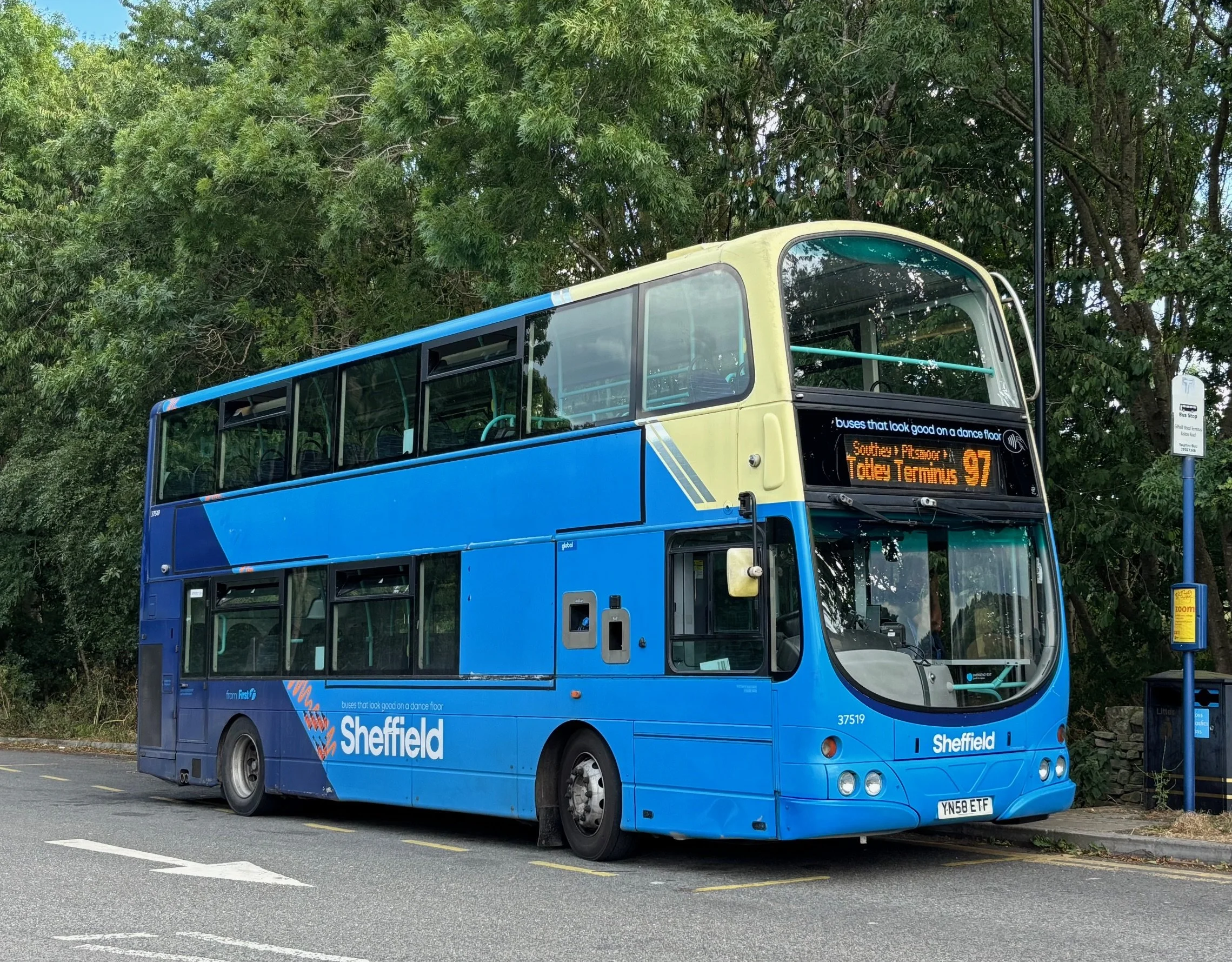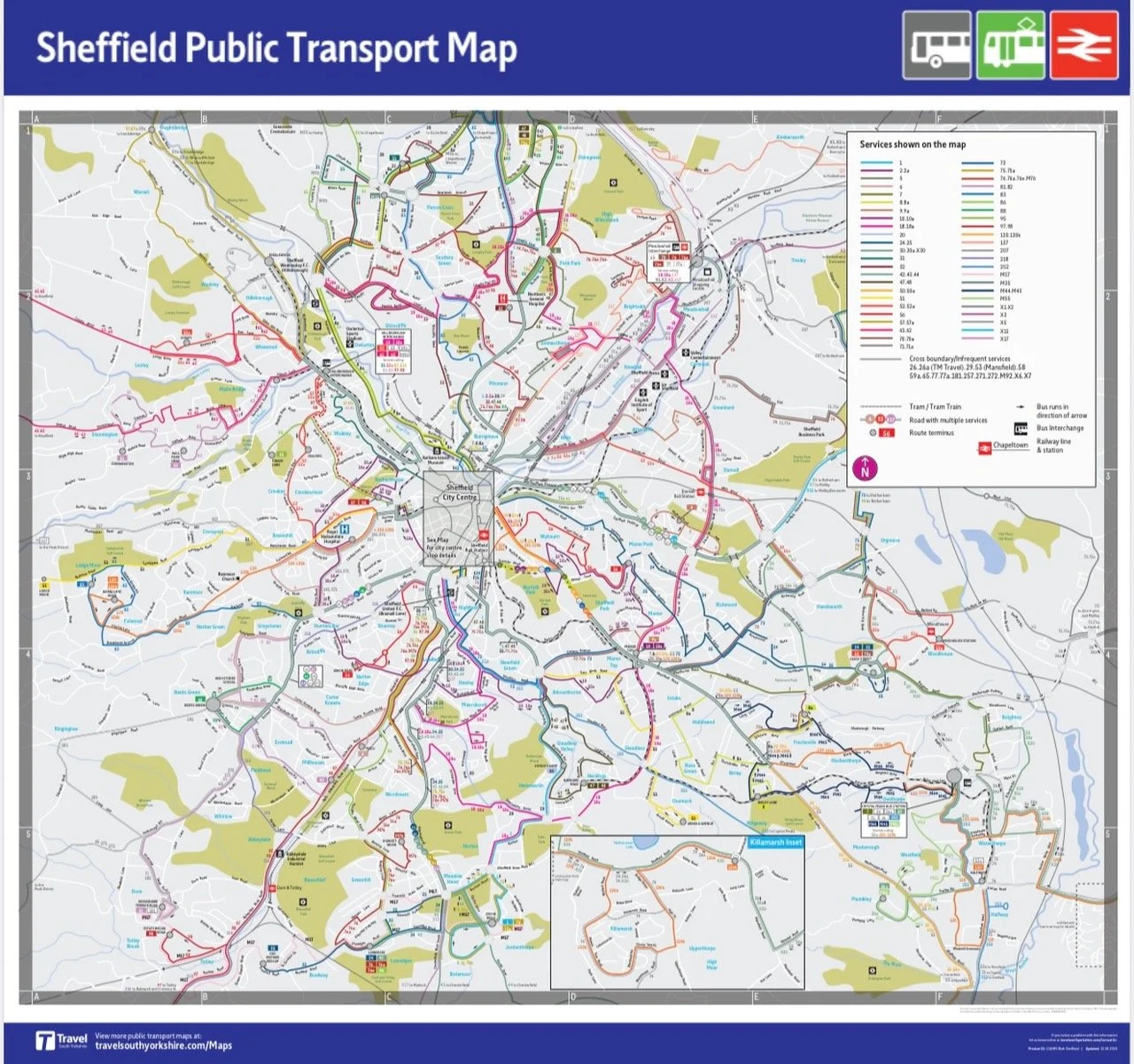South Yorkshire East to West
In the first article of a series of three focused on South Yorkshire, Watton’s Wanderings takes a trip by bus from Doncaster to Sheffield and samples a spoonful of local routes in the city famed for the manufacture of cutlery.
Arrival
Day 1. Alighting the LNER Azuma service at Doncaster, I noted the famous railway works known as “The Plant” beside the station, of which just a small part remains in use today. Outside the station is this recently unveiled plaque to Sir Nigel Gresley, CME of the original LNER, responsible for designing numerous steam locomotive classes such as the A3 and A4 Class Pacifics, which famously included “Flying Scotsman” and “Mallard”, the latter still holding the world speed record of 126mph for a steam loco.
Across the square from the plaque, I saw the artwork celebrating the town’s railway engineering and horse-racing heritage, which consists of 47 steel monoliths, with 28 detailing the names of St Leger winners, 12 featuring engineering drawings and 7 celebrating speed with images of train journeys. The sculpture is around 40 metres long and includes water features.
First Yorkshire Route X3: Doncaster to Sheffield
Adjoining the railway station is Doncaster Interchange, a massive subterranean Bus Station, under cover with enquiry office, toilets and retail outlets. Poster Maps, Where to Board Your Bus diagrams, Stop Specific Timetables and Electronic Next Bus Departure Screens, but no paper maps or timetables available unfortunately.
My first route was the trunk X3, Doncaster to Sheffield, operated by First South Yorkshire. Volvo B9TLs are the standard fare, with examples in various liveries, although many are in a red, yellow and magenta livery, some with signwriting for the service which is marketed as “mainline”. This is a throwback to the late 80s / early 90s, when South Yorkshire Transport introduced the brand across certain routes, initially with different colours for Doncaster, Sheffield and Rotherham, although all were eventually combined in a red and yellow scheme under a single “Mainline” fleetname across all services. After being sold to its employees in a management buyout, eventually First became the operator and buses began to appear in the familar “Barbie” livery.
The X3 operates to an approximate 20 min M-S daytime frequency, Hourly eves and Suns, although First has adopted the unfortunate practice of “dynamic timetabling”, whereby individual journeys at specific times of day are given variable running times, producing uneven intervals of a few minutes less or more than the standard frequency. Not easy for passengers to remember exact timings - better in my view to allow more recovery time at terminals and in the city centre at peak times whilst keeping to standard intervals as much as possible.
My bus was fleet no 36273, in “mainline” livery without signwriting, but with a pleasing red and black moquette plus yellow headrests on the seats. Only a couple of us boarded at the Bus Station, although we soon began picking more up as we made our way through Doncaster. Plenty of First buses in evidence in the town, in a variety of liveries, ranging from the original grey, blue and pink, the updated version of the same, an attractive red, magenta and cream “Doncaster” scheme and the latest corporate dark blue and grey with new “first bus” logos. Retro liveries also seen, including examples in Doncaster Corporation and South Yorkshire Transport colours.
After making our way out of town along the Balby Road through urban development via Warmsworth, we reached the town of Conisbrough, where we circumnavigated the ruins of the castle, sitting atop a hill and dating from the 11th Century, before reaching the striking St Peter’s Church and the town centre with its narrow streets. The town was once known for glass-making and is famous as the birthplace of the Kilner Jar. Beyond this, we continued through a short stretch of open country, before reaching the main intermediate town of Rotherham. This has another under-cover “Interchange”, although smaller than that at Doncaster.
We were a few minutes down by this time, although a built-in “hesitation” at Rotherham Interchange meant we left only a couple of minutes late. As we left, I noted the Grade 1 listed Rotherham Minster, with its tall spire and gothic sandstone architecture. From here, we progressed along a “Busway” and through the industrial heart of the area with various steel industry related factories. Our next main port of call was at Meadowhall Interchange, yet another large Bus Station, serving the massive retail centre to the north of Sheffield. Back on time, we continued along the Attercliffe Road passing the Valley Centertainment, Sheffield Arena, Ice Sheffield and English Institute of Sport, before arriving finally into Sheffield City Centre.
We terminated at Sheffield Interchange, adjacent to the railway station, after an interesting run of 1h35m. However, the location seems somewhat under-used - despite having around 30 stands, many are not utilised or have infrequent departures on out-of-town services - most of the cross-city services serving the Arundel Gate Interchange (actually stops either side of a main road), closer to the heart of the city and a few minutes walk away.
I made my way to the Cathedral, which is a former Parish Church elevated to cathedral status in the early 20th Century, centre of Tram operations, which I will cover in the next article.
First South Yorkshire Volvo B9TL 36573 at Sheffield Interchange after my trip on it from Doncaster, this bus being based at the depot in the latter town.
Several buses are in this red, yellow and maroon scheme for the X3 route, some having additional signwriting with the name “mainline” and a line diagram of the points served. Note the red/black moquette and yellow headrests on the high backed seating.
First Yorkshire 48: City Centre - Shiregreen - Herdings - City Centre
Unlike some of the smaller Northern towns, where it is possible to ride a number of short local services in succession, many of them circulars, the majority of routes in Sheffield are lengthy cross-city affairs, taking over an hour end to end.
I started with the 47/48 routes, which operate from Shiregreen in the north via the city to Herdings in the south-east, the latter having a long terminal loop, where the 47 runs clockwise and the 48 anti-clockwise. Buses run alternately on each route during daytimes, with a joint 10 min interval M-F, 12 min Sats and 20 min Suns. An Hourly service operates evenings daily on the 47 only.
These routes seemed to be mainly single deck, although a few deckers were out in support, including Volvo B9TL 37448 in old style First livery, which I boarded at Arundel Gate for a round trip. I discovered that this was a former First Manchester vehicle, with original purple moquette seating. A bit of a slog through the afternoon traffic out of the centre to the north along the Barnsley Road to the Northern General Hospital. Then a bit of greenery alongside Firth Park to the terminal loop at Shiregreen, a typical housing estate, where we took a short layover after a 35 min run.
On departure, we continued on around the loop and back to the city centre the way we had come, although the earlier traffic issues seemed to have resolved themselves. In common with most services crossing the city, a few minutes “hesitation” at Arundel Gate, where driver changes often take place. Continuing on through the heart of the city, we crossed the Ring Road and passed the delightfully named Olive Grove Depot, the centre of First operations in Sheffield. The city is extremely hilly and we soon began climbing towards the lengthy circular section through the Gleadless Valley to the terminus half way round at Herdings, through standard urban scenery with the odd green spot here and there. Around an hour end to end on this route.
A couple of minutes hesitation enabled a good view of the city below, before continuing around estate roads back to the centre, a 25 min trip, where my rides ended for the day.
This Volvo B9TL, fleet no 37448, in the old style First livery at Arundel Gate in Sheffield City Centre is seen after my rounder aboard on Route 48 (Shiregreen - Herdings).
Now based at Olive Grove Depot in Sheffield, this bus is a transfer from First Manchester.
First Yorkshire 20: City Centre - Ecclesfield - Hemsworth - City Centre
Day 2 of my visit began with another cross-city marathon rounder on Route 20, where I found a former First Glasgow Volvo B9TL, 37543, with light blue front end and standard liveried rear at Arundel Gate. Inside, an unusual touch was wood-effect flooring rather than the usual First purple linoleum. A 15-20 min frequency M-S daytimes, 30 min Sun daytimes and Hourly evenings daily on this service. Another mix of single and double deckers in evidence.
The 20 operates north west of the centre, initially over the same route as the 48 I had ridden the previous day, before branching out through suburbia to Southey Green and Ecclesfield, where we terminated at the High Street of this small town. 35 mins on this leg, which was reasonably well used.
The return run was busier than the outward, with many shoppers making their way into the city centre. After the obligatory hesitation at Arundel Gate, we continued south along the Chesterfield Road, before turning off along a very narrow uphill section. It was here that we met a Volvo B7RLE coming the other way at a sharp left turn - with parked cars each side, no-one was going anywhere! Eventually, the owner of a shop on the corner moved some tables and chairs to allow us to mount the pavement and continue past the other bus and on our way again. More hilly terrain and estate roads brought us to the terminus at Hemsworth, incidentally part way around the 47/48 loop I had been on the day before. Sadly, the “John O’Gaunt” pub at the terminus was closed and boarded up, an all too frequent occurrence these days. 65 mins end to end on this route.
An usually long layover of 15 mins before we continued back to the city centre, where I alighted after a 30 min ride.
Another Volvo B9TL, 37543, at the Ecclesfield High Street terminus of Route 20 during my ride on the route, before proceeding via the city centre to Hemsworth.
This example with light blue front end is one of a handful of the type now at Olive Grove Depot that transferred from First Glasgow.
Stagecoach Yorkshire 25: City Centre - Bradway - Woodhouse
I then switched operators to sample some of the Stagecoach routes in the city. Stagecoach Yorkshire was formed in 2005 following takeover of the Traction Group, to run the operations of Yorkshire Traction, Yorkshire Terrier and Bransley & District in South Yorkshire. Since then, certain services in the Huddersfield area have been divested, whilst Derbyshire operations around Chesterfield have transferred from Stagecoach East Midlands. Double deckers in Sheffield comprise mainly Enviro400s, of both “classic” and MMC variety, although there are also some hybrids. Electric deckers work into the city from Chesterfield and will be covered in Part 3 of this series.
I began with a southbound working on Route 25, another mix of double and single deck vehicles, although I chose an Enviro400, 19452, one recently made redundant in Manchester following service changes in conjunction with the “Bee Network” there. The route is run by Holbrook Depot, one of two in the city, the other being Green Lane Depot, Ecclesfield. A 15 min frequency operates M-S daytimes, with First providing a limited evening service, although their Route 24 parallels much of the 25 and runs daily.
Soon we were off and made our way along the busy London Road to the Chesterfield Road, passing a mix of retail, industrial and housing areas, before climbing out of the city to Meadow Head. Turning off, we progressed through the Lowedges estate, where the largely parallel 24 terminates at the shops. However, the 25 continues on to the next village of Bradway, terminating at the “Old Mother Redcap”, another closed pub, although this one at least had a notice on the door asking for a live-in management couple to run it! 40 mins from the city to this point.
After a 10 min break, I reboarded for the return trip, back across the city and on to the eastern terminus at Woodhouse. Beyond the centre, the route takes a hilly route through the suburbs of Manor Park and Richmond Park to Woodhouse, finishing in the town after serving a one-way loop through a nearby estate. 1h10m trip time. Woodhouse is a former farming and coal-mining village, now a suburb of Sheffield.
Stagecoach Yorkshire Enviro400 19452 is at the Bradway terminus of Route 25 to the south west of the city, before proceeding across the centre to Woodhouse in the east.
This vehicle, which is in the relatively new livery now in turn superseded by plain dark blue, has been transferred from Stagecoach Manchester following recent service losses there under the Bee Network scheme.
Stagecoach Yorkshire 52: Woodhouse - Hillsborough
At Woodhouse, I walked around the corner in the town centre to the nearby stop for Route 52, another service of mixed vehicle types. I was lucky that a further ex-Manchester Enviro400, 19457, another Holbrook Depot inmate, was on the stand, although this one was in the older “beachball” livery rather than the newer version of my previous bus. The 52 runs every 15 mins M-S daytimes, every 30 mins eves & Suns, although First Yorkshire Route 52A runs in tandem for much of the way and provides additional journeys over the common section.
We departed and picked up in Woodhouse Town Centre, before proceeding via the station and on through leafy suburbs to nearby Darnall, pausing due to early running in the High Street. Continuing on along the main road, we began a slow descent down into Sheffield City Centre, merging onto the Attercliffe Road. The principal central stop is in Church Street, near the Cathedral, but we continued on without pause after exchanging passengers. Following the tram tracks a short distance, the 52 then deviates from the University via various hospitals uphill to the suburb of Crookes. After serving the High Street shops and disgorging most of our load, we continued down the other side of the steep hill via a winding main road into Hillsborough, terminating opposite the Interchange. 1h10m in all from one end to the other.
Another transferee from Stagecoach Manchester to Sheffield is Enviro400 19457, pictured opposite Hillsborough Interchange, terminus of Route 52, after travelling on it from Woodhouse.
This vehicle bears the older “beachball” livery that arguably looks better than either of the schemes that have superseded it.
First Yorkshire 97: Hillsborough - Totley - City Centre
To end the day, I returned to First Yorkshire and Route 97. This operates in tandem with Route 98 from Hillsborough across the city to Totley, although with different end terminals at the latter location. A joint 15 min service applies M-S, 30 mins eves & Suns, alternately on each route. Once again, both double and single deck vehicles are evident on these services.
My bus this time was a South Yorkshire original, Volvo B9TL 37519, one of many in an attractive light/dark blue and cream local livery for Sheffield, which sadly is now being superseded by the latest First Bus corporate scheme before the roll-out was ever completed, one of the downsides of constantly changing liveries.
The route describes a large question mark shape, looping around from Hillsborough to the City Centre via a series of northern suburbs and taking much longer than the more direct tram! We began by traversing Leppings Lane, near to Sheffield Wednesday Stadium, before serving various estate roads in the Southey Green area. Our driver turned off the engine at the shops and said he was 7 mins early - clearly plenty of padding in the mid-afternoon timetable! After we got going again, we met up with Route 20 again, on which I had started the day, but instead of following this direct into the city, we described a dog-leg through the Pitsmoor area before rejoining the main drag at Burngreave, just north of the centre.
Taking the obligatory few minutes pause at Arundel Gate, we continued on southwards, taking London Road before turning onto Abbeydale Road, another main street parallel to Chesterfield Road. After entering a green valley in the Millhouses Park area, with lots of adjacent parkland, we reached Dore & Totley Station, where the main lines towards London and Manchester diverge. Totley itself is an area of ribbon development, but whilst the 98 turns off towards Totley Brook, our 97 continued on the main road to Totley Village, where everyone except me alighted. It was then a delightful and speedy run through open countryside for about a mile to the remote terminus at Gillfield Wood, ideal for hikers and bird watchers, with nothing but trees and hills around. I can only assume that this is the first convenient point beyond Totley Village for the bus to turn as it is unlikely to elicit much custom! A long 1h30m trip but with a satisfying conclusion.
The 15 min layover enabled me to take a short country walk, before rejoining my bus for the trip back to town. Traffic was light as we were going “against the flow” and despite picking up a few takers, we only took half an hour back to Arundel Gate, where my rides ended for the day.
Volvo B9TL 37519 on Route 97 stands at the remote Totley Gillfield Wood terminus, which is a mile or so beyond the village in the middle of nowhere!
Many First vehicles in Sheffield bear this pleasant two tone blue and cream scheme. Some have witty straplines, like this one, which says above the front destination screen and on the side panel above the Sheffield fleetname “buses that look good on a dance floor”!
A Brief Word on Single Deckers
Whilst I didn’t have time to sample any single deck buses during my trip, they nevertheless play a significant part in the fleets of both First and Stagecoach in South Yorkshire. As mentioned earlier, mixed double and single deck operation feature on several routes in Sheffield. First have a number of Volvo B7RLE Wright Eclipse and Wright StreetLite saloons at work in the area, whilst Stagecoach operate Enviro 200s, Enviro300s and Wright StreetLites.
Electric Yutong E10s can be seen on Stagecoach routes into Sheffield from Chesterfield, whilst there are a couple of free City Centre circular routes, SC1 and SC2, operated by South Pennine Community Transport using light green liveried Enviro200 EVs.
Although I didn’t ride any single deckers on this adventure, First Volvo B7RLE 69514 in two tone blue Sheffield livery illustrates the type on Route 76 (Meadowhall - Lowedges via City). This bus was formerly with First Essex.
To the left is the Arundel Gate Interchange Bus Enquiry Office. Whilst providing information and period tickets, no paper timetable leaflets or maps are available for city services, a serious omission in my opinion.
This Sheffield Public Transport Map is published by Travel South Yorkshire. It appears on some bus shelters and is available to download, although unfortunately a printed version is not available. Similar maps are produced for Barnsley, Doncaster and Rotherham.
Still to come…
Part 2 of this trilogy will cover the Sheffield Supertram and Tram Train, whilst Part 3 will look at other aspects of double deck operation in the area, including Open Toppers and Electric double deckers in and around neighbouring Derbyshire.
Watton

